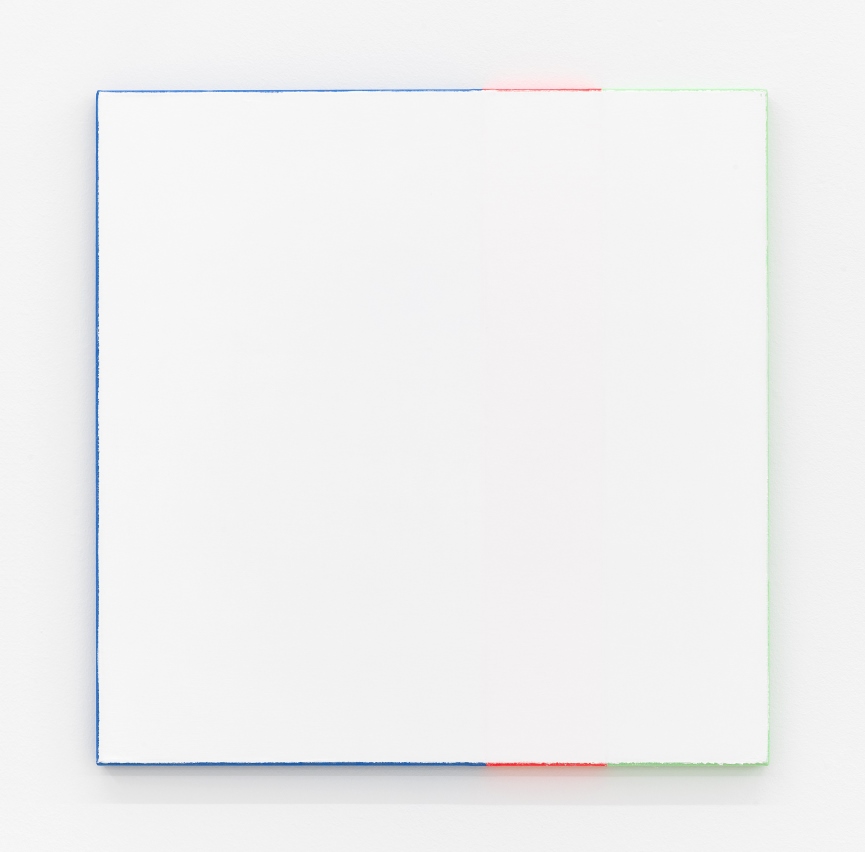Heimo Zobernig at Nicolas Krupp Contemporary Art
The fourth exhibition of the Austrian artist Heimo Zobernig (*1958 in Mauthen, Carinthia) at Nicolas Krupp Contemporary Art presents pieces from a cohesive body of works:
Upon entering the gallery spaces, one first sees everything in white—nine monochrome white tableaux are hanging on the walls—until one notices curious red, green and blue tinges coming from the sides of the individual “panel paintings.” When taking a closer look at the pictures, the reason for this emanation becomes clear: The stretcher frames are spanned with colored polyester fabrics, some with several sewn strips in the three mentioned colors, others in just one color. The colored canvases are overpainted with white—except for the side edges whose bright colors are reflected onto the gallery walls by the neon light.
The fabrics employed here as the painting ground are quite familiar from other works by Zobernig—fabrics used in TV and movie productions for so-called chroma keying, a technique with which figures are filmed against a monochrome background (in video blue, video red or green screen). This allows replacing the backdrop of the figure with an arbitrary one. The fabrics used as material carriers in these images are meant to disappear, allowing other spatial contexts of depiction to appear. They are backgrounds conceived for other backgrounds.
The white color constituting the painting as a painting seems to have been applied using a roller. The originally different colored canvases are painted like the background of the artworks in the gallery itself—white, like the walls of the white cube.
The chroma keying fabrics are carriers for something else, as is also true of empty canvases or white gallery walls. The white cell facilitates viewing art objects in a neutral context as isolated, independent forms. In this respect, they function similar to the blue, red or green box in the filmic method of chroma keying.
The tableaux in the exhibition are conceived in such a way that the reception process is predetermined. The viewer registers the visually unambiguous information as if he or she were in a show displaying abstract white pictures. Since, on the level of the technical make, the works reveal something seeking to be decoded, the viewer steps closer. Upon approaching, the material raises questions triggering an interpretation process that turns the viewer into an actor in a choreography formulated by the artist.
The peculiar quality of the paintings is reinforced, if not evoked, by the neon light and the color of the gallery walls. The visual attraction inherent to the paintings is precarious, since it is made visible only by the neon tubes in the white cube. If these panel paintings would be viewed in private spaces, where the lighting is rarely optimized accordingly, the side edges of the pictures would no longer reflect evenly or at all. Outside of the gallery, the painting could very well lose its nimbus.
In addition to these interpretations derived from the material properties of the works, other approaches suggest themselves. The paintings could be read as a contribution to various debates in the discourse of art since modernism, for example, as an examination of the relationship between painting and video, or as a continuation of the modern discourse on the panel painting, since, after all, the pictures are all “white squares.” The works could also be situated in a discourse on Minimalism or read as a formal deliberation on the relationship between material carrier (canvas) and picture, because it is the material carrier that makes the picture a picture which can be distinguished from the wall. One can also interpret them as a problematization of the culturally highly valorized panel painting, if one grasps the pictures as pure functional carriers within the gallery space—as objects whose purpose it is to be turned into an aesthetic experience through the beholder.
All of these aesthetic debates resonate, but they don’t get us very far; Heimo Zobernig merely cites them and thus holds a mirror up to the viewer. He demonstrates how the gallery-goer approaches the works by means of traditional cultural interpretation keys. The pieces are overloaded with discourses, and that’s where their potential lies. They are recalcitrant provocateurs exposing the mechanisms of producing meaning.
Hence, one turns into the witness of one’s own mechanisms of attribution, becoming aware of one’s projections when walking through the gallery—projections evoked by the history of theoretical and artistic engagements with the format of the tableau.

